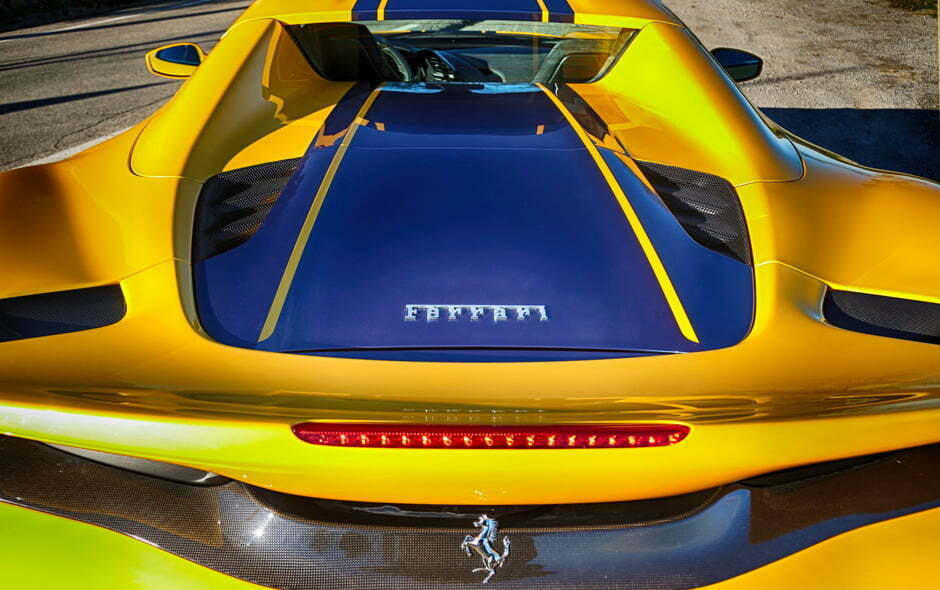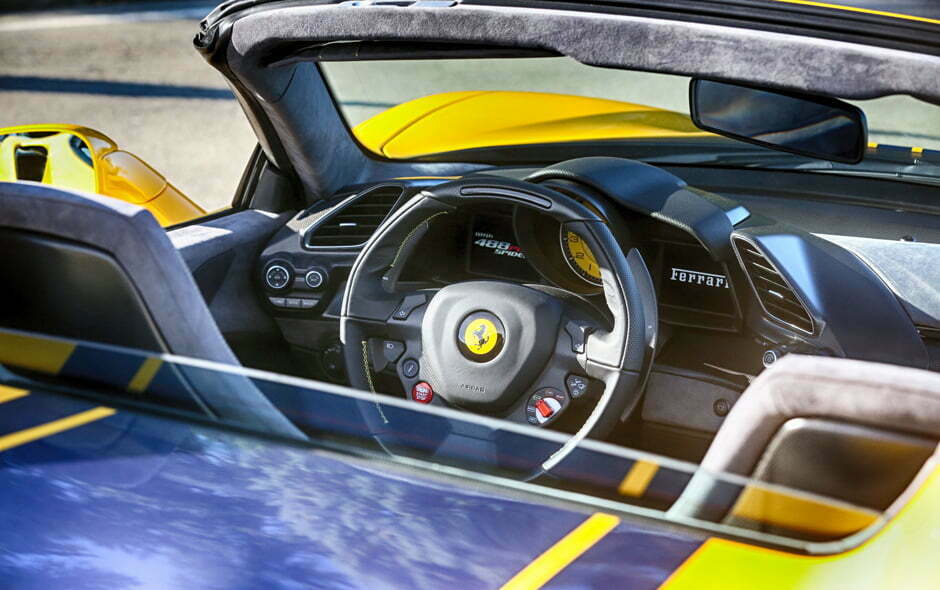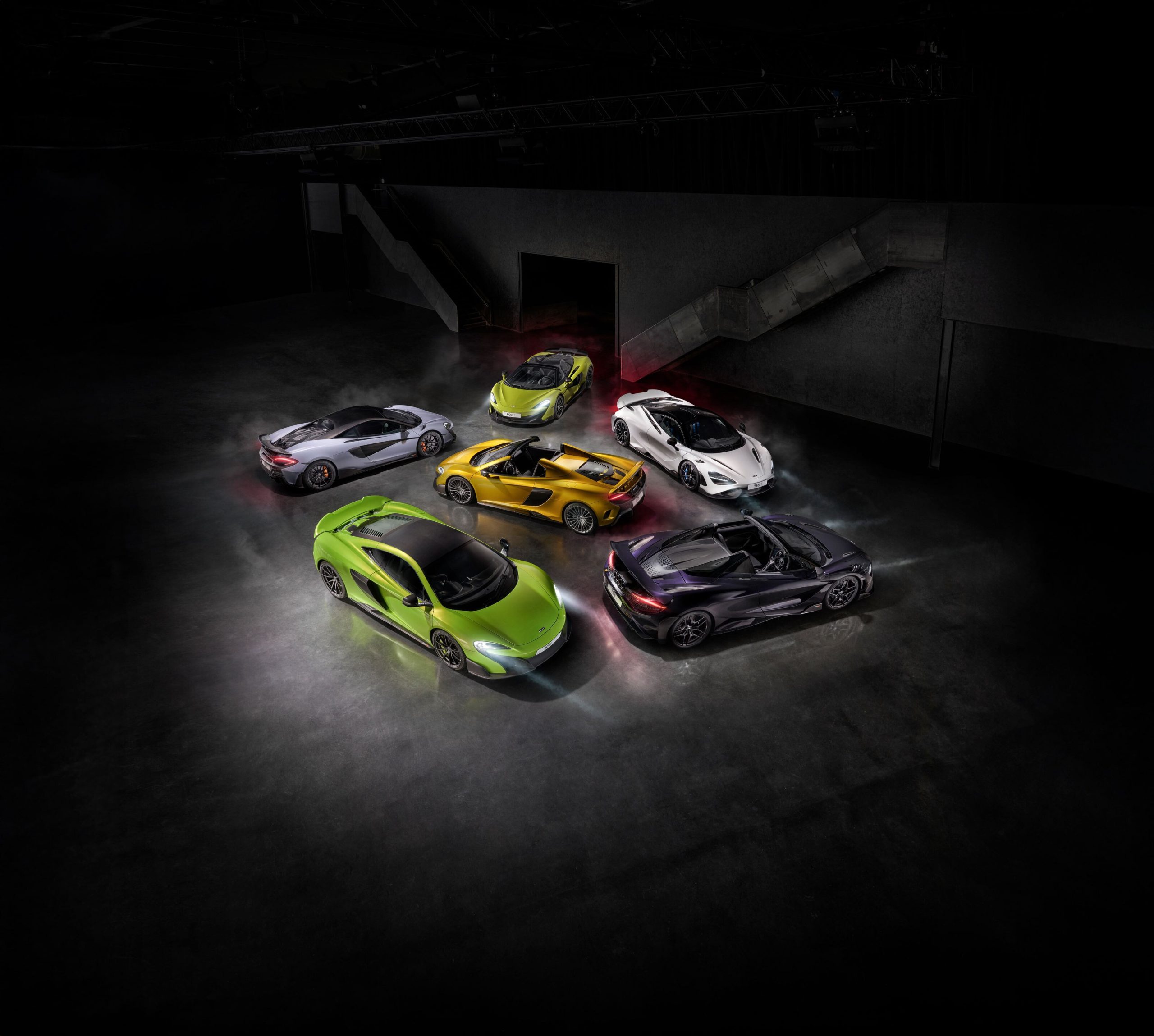
The 488 Pista Spider Driven In Maranello, Italy.
P: Lorenzo Marcinno
When Ferrari introduced the 360 Modena they had already hatched a clever plan to extend the shelf life of the 360 Modena by way of a lightweight racetrack ready street-legal version called the 360 Challenge Stradale midway through its life cycle. It would be a higher powered, track focussed version with better suspension, tyres and chassis lightening.
This would become the blueprint for all the following mid-engine V8 sports cars with one difference – they added the Spider version. So the following models such as the F430 had a 430 Scuderia and 430 Scuderia Spider 16M. Same for the 458 Italia with the 458 Speciale and 458 Speciale A Spider.
There is a reason for this process and in engineering terms this is internal benchmarking. The special track version of the model will set a higher benchmark for performance in terms of acceleration, handling and lap times. This would have to be met by the replacement model. So for example the standard 488 GTB had to meet all performance markers set by the 458 Speciale. You could say the 458 Speciale was beta-testing for the 488 GTB though in reality it is a very carefully upgraded 458 Italia which is why it is usually the more sought after model even in the secondary market.
Ferrari’s current V8 mid-engine supercar the 488 GTB is now just past its mid-life marked by the launching of the 488 Pista (which means track in Italian) last year. Earlier this year Ferrari released the 488 Pista Spider which is essentially the hardtop convertible version of the 488 Pista. At a distance it is hard to tell the coupe and spider versions apart. On closer inspection one will notice the shut lines of the roof and the thick C-pillars which are really the flying buttress when the top is down. So close is the external form with its top up that its top speed of 340 km/h is identical to the 488 Pista coupe.
THE AERODYNAMICS
Ferrari is a master of aerodynamics with a full scale wind tunnel on their premises to engineer their F1 race cars. Not surprisingly they have used it on their road cars and obviously aerodynamics play an important role in how quick the Pista can be around the track. At 200 km/h the aerodynamic package is already generating 240 kg of down force, some 40 kg greater than the 488 GTB. Here is how they achieved the overall downforce.
There is a large duct visible when you stand in front of the Pista Spider exiting above the front nose section. Ferrari calls it an “S-Duct” which is really a combination of a venturi and a front wing. The narrowing of airflow in the S-duct increases air velocity which develops downforce in what is essentially an inverted double front wing in cross section disguised as the nose section.Engineers completely repositioned the front radiator now downward facing for a 7% improvement in cooling ability but overall generates 12% of the increased downforce.
The rear airflow has also been reconfigured. The air intakes are now relocated to the high pressure area found at rearmost of the rear deck. The original intake ducts in front of the rear wheel arch are now dedicated to the intercoolers. The hot radiator discharge air has been cleverly used to create an invisible wind fairing around the front tyres cutting drag there by 7%. The hot air discharge from the front discs have been redirected away from the rear intercooler vents in front of the rear wheel arch improving intercooling performance by 10%.
The use of underside vortex generators and the front and rear diffusers account for 18% extra downforce. The sides of the front spoiler just ahead of the front wheels have winglets and the detailed design alone generates 23% of the increased downforce. Another 15% is generated by the larger rear wing. This wing sits 30mm higher and 40mm wider compared to the one on the 488 GTB.
THE ENGINE
Turning to the engine, the engineers needed to extract an extra 50 hp from the 3.9-litre turbocharged V8. Turning up the boost might do for aftermarket tuners but Ferrari has extensively redesigned the V8 engine for reliability and significantly reduced the weight to produce that extra edge.
The intake runners have been completely redesigned for better flow with a smaller plenum volume and shorter intake runners so that turbo boost builds up more rapidly to help reduce turbo lag further. Even the titanium valves came under scrutiny and they are hollow to pare weight for inertia reduction. This helps as the camshafts are altered for more lift and duration which means the valves have to travel further and faster. Lighter valves means less stress and inertia on the valve components.
The turbocharger turbine runs smoothly on ball bearings with a special sensor to tell exactly what rpm the turbine is running at. There is a new inconel alloy exhaust system that not only scavenges the waste gasses better, but it also sounds better.
The weight reduction in the engine
Inconel Exhaust system 9.7 kg
Connecting Rods 1.7 kg
Flywheel 1.5 kg
Cylinder liners 1.3 kg
Crankshaft 1.2 kg
Valves and springs 0.3 kg
Other parts 2.3 kg
The result is a spectacular engine that develops 720 hp at 8,000 rpm and is 18 kg lighter than the standard engine. Ferrari’s party trick called Variable Torque Management tailors the torque curve differently for all the gears. The first three gears have the same torque curve, allowing it to rise in a linear manner to a peak near 6,700 rpm just like a strong natural aspirated engine.
In 4th gear the torque is allowed to rise more in the low to mid range, peaking again at 6,700 rpm. The same increments appears each in 5th and 6th gear. However in 7thgear the engine is allowed to behave like a normal turbocharged engine with a peak torque of 770 Nm occurring at 3,000 rpm. This is the key to the sheer drivability and low-lag delivery of this engine. It just feels like a muscular, high-revving normally aspirated engine.
Of course the screaming wail of Ferrari’s natural aspirated engines are sorely missed and unfortunately it is a thing of the past but the 488 Pista’s engine mitigates that with its mind-boggling acceleration. 0-100 km/h arrives in just 2.85 seconds and 200 km/h is dispatched in 8.0 seconds. It is not so much like being fired out of a canon but rather being launched by a rail-gun. It’s best to make sure the road up ahead is clear before you mash the accelerator to the carpet.
Since the 458 Speciale, Ferrari has been using the UHP (Ultra High Performance) Michelin Cup 2 tyres. There is even an optional 20-inch Carbon Fiber wheel for the Pista that is 40% lighter than the already lightweight forged rims. The Michelin Cup 2 tyres impart a secure feel at the helm that is very similar to other extreme sports cars shod with them giving a high degree of confidence and progressiveness that allows the driver to push easily to the extreme limit. But even the super grippy Michelin Cup 2 tyres scrabble for grip when accelerating hard in the first three gears.
Yet for all that cornering prowess, the 488 Pista Spider does not have a punishing ride. The Manettino has selection for Wet, Sport, Race, CST off and FDE off – however Sport mode is the minimum setting on the Manettino but can be further tempered by a “bumpy road” button on the steering which reduces the damping, allowing the suspension to traverse the bumps less firmly.
But with 720 hp, the 488 Pista Spider does squirm a bit on uneven surfaces or poorly paved roads but it is nowhere as intimidating as the F12. Here it is impressively well controlled thanks to the SSC6 (6th generation Side Slip Control). The power on-board stability control system controls the e-Diff, F1-Trac, SCM and new for this generation, FDE (Ferrari Dynamic Enhancer). FDE is the new software and hardware that provides earlier intervention by being predictive, which means the system is already pre-programmed for initial intervention as the car reaches the limits.
It is so clever that one does not even feel the electronic nanny system. The slides are progressive and smooth which makes the driver feel like a hero. However it is not foolproof and is not a miracle fix for those foolish enough to throw caution to the wind and disregard the laws of physics. But for those who do understand how the FDE works, it really makes driving such high powered cars less daunting.
CONCLUSION
Obviously being the open top version the 488 Pista, Ferrari is targeting the less hardcore clients. However, having said that, the 488 Pista Spider is much more engineered and every bit as special as the 488 Pista coupe. The retractable hardtop adds about 100 kg of weight and reduces the body strength but there is one immutable advantage when driving with the roof open – the fantastic sound track of the award winning engine singing melodiously when one is gunning hard, something not heard in its full glory in the closed coupe.
Being so hardcore the 488 Pista coupe will only be enjoyed at the track but the Pista Spider is meant to be thrilling from half that pace and behaves impeccably on the open road. The way it scythes through a sequence of corners is just so rewarding even with the top down.
This is perhaps Ferrari’s finest moment – just from listening to the glorious V8 note, savouring the absolutely connected steering and enjoying the superbly sorted chassis. And all it took to convince us was a quick blast down a meandering country road. The 488 Pista Spider is at the very top of its game and could well be the last generation of cars to deliver such decadent pleasure. If your name is not on the booking list it may already be too late.
Car: Ferrari 488 Pista Spider
Engine: 3902cc,32-valves, V8 twin-turbo
Transmission: 7-Speed F1 DCT
Power: 720 hp at 8,000 rpm
Torque: 770 Nm at 3,000 rpm (7th gear)
0-100 km/h: 2.85 seconds
Top Speed: 340 km/h
Fuel Consumption:12.8 litres/100km (combined WLTP cycle)









































